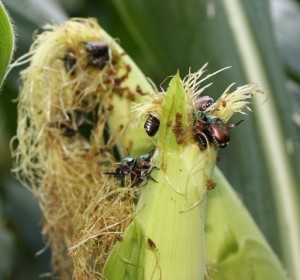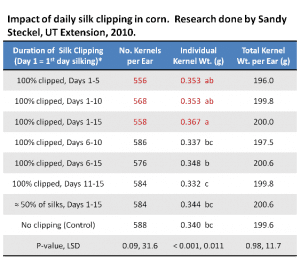Japanese beetles are showing up in corn, soybean and cotton. Of these cotton is their least favorite. These showy beetles often hang out in groups and draw a lot of attention. Fortunately, they rarely cause yield loss in field crops. The beetles will feed on leaves, flowers and corn silks. Japanese beetles have a wide host range which includes many ornamental plants. They were introduced into the northeast U.S. nearly 100 years ago and have been slowly spreading south and east ever since. They only have one generation per year, and the adults started emerging last week. Adults will continue to emerge for several more weeks and will persist into July. Larvae are white grubs that feed underground and are sometimes a pest of turfgrass.
I don’t think there are any documented examples of yield loss caused by Japanese beetles in West Tennessee. However, I’ve observed a few examples where they have caused enough defoliation in soybean to exceed our treatment thresholds. In soybean, treatment would be recommended prior to bloom if defoliation exceeds 30% (dropping to 20% once the plants are blooming). Synthetic pyrethroids such as Asana XL, Baythroid XL, Brigade, Mustang Max and Karate/Warrior would all be expected to provide control.
In corn, the concern would be excessive silk clipping which could cause pollination issues. Treatment is generally not recommended in corn unless multiple beetles are found per ear. The vast majority of pollination occurs within 7-10 days after silking begins. Keep in mind that infestations are often worst along field edges, and silks have to be clipped prior to pollination for feeding to have any effect. Even then, clipped silks can re-grow if they are not pollinated.
A common treatment threshold used by our neighboring states to the north is an average of 3 beetles per ear during pollination.
Last year, we began doing some research on the impact of silk clipping on pollination. In the table below, silks were clipped with scissors daily for various length of time. Clipping 100% of the silks daily during the first 5 days of silking reduced the number of kernels per ear. However, the remaining kernels were larger and no yield losses were observed (see table below). We are repeating this test and are also doing some caging studies. It would be premature and probably wrong to say silk clipping can not affect yield. Environmental stresses and pest pressure could certainly play a role. However, I am convinced that it takes high levels of clipping during early pollination to cause significant problems. I suggest using the threshold mentioned above!



